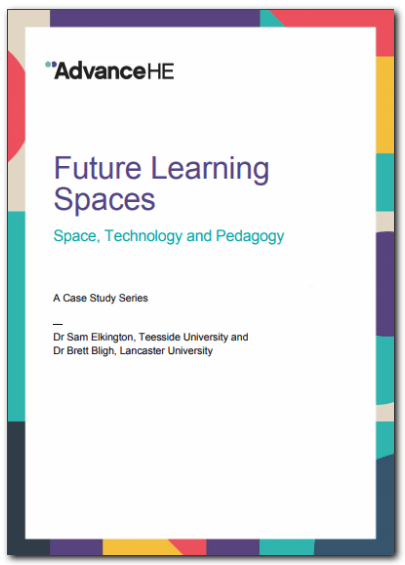
To mark the publication of Advance HE’s Future Learning Spaces in Higher Education: Space, technology and pedagogy case study series, Dr. Sam Elkington (Teesside University, formerly of Advance HE), the series convenor and editor, discusses the significance of better understanding the interplay between space and learning as an important, but overlooked dimension of teaching and learning processes in HE.
In his important 2007 publication ‘Learning spaces for the 21st century’, Paul Temple made the observation that the interactions between higher education, the built environment and the activities of teaching, learning and research taking place within and around it are poorly understood. Historically, noted Temple, in UK HE, space issues had typically been considered either in the context of space planning (the utilisation and optimisation of physical space) or as part of campus planning and building design. There has been steady growth in space-related research in the intervening decade since Temple’s work; however, a review of the available contemporary evidence reveals a dispersed and fragmented literature relating to understanding connections between learning spaces and student learning (see Ellis and Goodyear, 2016). Furthermore, a more recent sector-wide shift in emphasis from an ‘instruction paradigm’ to a ‘learning paradigm’, has meant universities must now think seriously about what it means to be a learner in these spaces.
Innovating spaces for teaching
At a time of significant estates development in UK universities, there is a pressing need to provide innovative spaces for teaching that meet the needs of 21st-century learners. It has been widely recognised that space – whether physical or virtual, individual or shared – can have an important impact on student learning. Recognising the changing educational requirements of increasingly diverse student populations, higher education institutions have responded with increasingly tailored, student-centred, approaches to learning space design. As we have come to understand more about today’s learners, alongside the ready availability of digital technology, our own notions of what comprises effective learning spaces have also changed. New strategies for enabling learning and accommodating the multiple demands on today’s students have necessitated a fundamental rethink of the use, design, and location of learning spaces. Increasingly, approaches to learning are required to be flexible and networked, bringing together formal and informal activities in a seamless environment that recognises that learning can take place any time, in physical and virtual spaces.
There is a broad acceptance in the literature that the design of the ‘learning landscape’, taking in the various spaces around the university campus and within its buildings, can help to create an important sense of belonging and qualitatively different patterns of student engagement. The learning landscape concept has been used to develop models of teaching at university that recognise that learning is not just confined to formal teaching spaces and that the quality of the student experience is impacted by all aspects of the physical environment.
The influence of today's digital technology
Looking beyond changing demographics and increasing diversity on campuses, our conceptions of learning space at university are increasingly influenced by the unique potential that today’s digital technology offers for enhancing the student learning experience in higher education. The ‘boundaries’ between the physical and the virtual have become blurred – permitting and promoting learning that is continuous, able to occur in any place and at any time. The use of new digital technology is making it possible for students and educators to work with knowledge in new ways – increasingly, today’s students are using digital technologies to discover and construct knowledge that is meaningful to them. Here, the development of future learning spaces can support innovative pedagogical approaches and environments through the affordances of digital technology. However, despite the interplay between spaces, technology and learning receiving growing recognition as fundamental features in the contemporary debate on learning and teaching in higher education, our understanding of the complex relationship between spaces and learning remains largely underdeveloped, lacking a clear evidence base.
Future Learning Spaces
Advance HE’s Future Learning Spaces programme was aimed at better and more fully evidencing and understanding the relationship and interplay between space, technology and pedagogy in effective learning space design. The newly published case studies series is the culmination of a body of work that began in early 2018 with the aim of bringing together a mix of academic, researcher, senior leader and estates personnel, to share examples of excellence in learning space design and practice, providing the opportunity for inter-professional collaboration and development. Capturing and building on several of the case study examples shared during the Future Learning Spaces programme, the case study series presents an attempt to usher in a broader emphasis on learning space design as ‘sites-for-learning’; and with it a more sophisticated appreciation for how space, technology, and pedagogy hang together and are used and developed to realise learning environments that are truly future facing.
Download the full case study series.
References:
Ellis, R.A. and Goodyear, P. (2016). Models of learning space: integrating research on space, place, and learning in higher education. Review of Education, Vol. 4, No. 2, pp. 149-191.